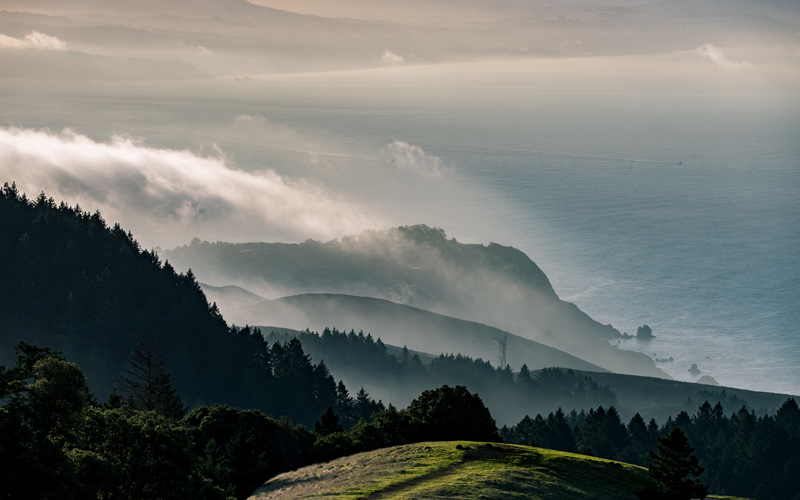The Strange Magic of Marin’s Serpentine Soils

By Matt Dolkas,
Senior Manager, Marketing
March 11, 2024
You might be surprised to hear that serpentine soil, a layer of apple-green to black colored earth well-known for its incredible toxicity, is actually one of the best places to see the spring wildflower bloom. If you’re looking for those big, showy displays of wildflowers, Marin’s serpentine soils are where it’s going down and now’s the time to be there (March and April).
Outcroppings of the Golden State’s official rock are scattered across much of the Bay Area (including many MALT-protected ranches), with the largest deposits in San Jose’s Coyote Valley. The popular theory for serpentinite’s origins is the metamorphosis of rock found deep in the earth’s mantle. As the plates smashed and grinded against one another, this low density rock surfaced along the Bay Area’s abundant fault lines, the remnants of our relentless geologic convergence.
With high concentrations of heavy metals and shallow depth, it’s difficult for even the most invasive of species to take root in the nearby soil. With limited competition for the ground’s meager resources, this soil type is home to a huge diversity of native plants well-adapted to the poor soils. Like small islands of native plant diversity, serpentine soils offers critical habitat to a host of native and often endemic plants (found nowhere else on the planet), including the Mount Tamalpais jewel flower, Marin dwarf flax, and serpentine leptosiphon.
It’s a bonanza of California native life and with spring underway, the show is just getting started.
Here’s where you can experience the magic of Marin’s serpentine soils:

Mount Burdell & Bowman Canyon Preserve
Often overshadowed by the popularity of Mount Tamalpais to the south, this county preserve boosts some of the best views in the entire North Bay area. And with many pockets of serpentine outcroppings, it is one of the best places to experience this unique soil type and the abundance of the spring wildflower season.
The hike along the Serpentine Fire Road (preserve map found here) cuts through one of the area’s biggest outcroppings of serpentine soils and the newest addition to this preserve, the Bowman Canyon Ranch. Even if you miss the peak bloom, the views from this section of the preserve are world-class.
When to visit: March through April
Where to park: View on Google Maps for directions to the Bowman Canyon section of this preserve
Dog-friendly: Yes! Dogs must be on a six-foot or shorter leash at all times
More information: Visit the Marin County Parks website for more information about this location
Ring Mountain
This Marin County Preserve has an exceptional biological diversity, including the Tiburon mariposa lily that is found nowhere else on the planet. The higher portions of the preserve are home to serpentine soils and offer some of the region’s most vibrant displays of native wildflowers.
The 1.76 mile Phyllis Ellman Loop Trail winds through the preserve’s oak woodlands and expansive grasslands. The 360-degree views of the surrounding urban areas make this a unique natural experience amid the heart of the Bay Area.
When to visit: March to May (the endemic Tiburon mariposa lily typically blooms in May)
Where to park: View on Google Maps for directions to Phyllis Ellman Trailhead parking
Dog-friendly: Yes! Dogs must be on a six-foot or shorter leash at all times
More information: Visit the Marin County Parks website for more information about this location

Old St Hilary’s Preserve
This 122-acres preserve within the heart of Tiburon provides some of the most scenic vistas in the entire Marin County area, including views of the Golden Gate Bridge, Angel Island, San Francisco, and surrounding metropolitan landscape.
The area around the historic Old St. Hilary’s Church (pictured above) is where you’ll find the best display of wildflowers amid an outcropping of this rare soil type. There is limited street parking so it’s best to get their earlier in the day if possible, especially on sunny weekend days.
When to visit: March to May (the endemic Tiburon mariposa lily typically blooms in May)
Where to park: View on Google Maps for directions to park near the Old St. Hilary’s Church
Dog-friendly: Yes! Dogs must be on a six-foot or shorter leash at all times
More information: Visit the Marin County Parks website for more information about this location

Mount Tamalpais
With the varied topography and soils, this park is home to a wide variety of wildflowers, including lupines, California poppies, goldfields, and many more. More than 750 plant species can be found in the park’s open grassland, chaparral, oak-covered knolls, dense stands of Douglas-fir and deep, fern-and redwood-filled canyons.
You’ll find the Serpentine Knoll on the northside of the mountain along the trail to Alpine Lake. With so many habitat types within walking distance, there are many places to experience the spring bloom and the range of plants this parks supports. It’s a steep landscape, so be prepared for a challenging hike amid breathtaking scenery.
When to visit: Late March to mid-April
Where to park: View directions on Google Maps to the Lower Northside trailhead parking area
Dog-friendly: Leashed dogs are allowed only on paved roads in developed areas
More information: From the California State Parks website
Look, Don’t Touch
We encourage you to view wildflowers in Marin County responsibly and you can do so by following a few simple guidelines.
1. Never pick wildflowers. Please leave them in place.
2. Do not illegally dig up wildflowers to transplant to your garden.
3. Watch your step — please don’t trample or crush wildflowers or other habitat areas.
3. Do not enter private property to view wildflowers.
4. Be aware of sensitive, overused areas and stay on trails and roads during hikes.
Discover More
Download our Wildflower Guide